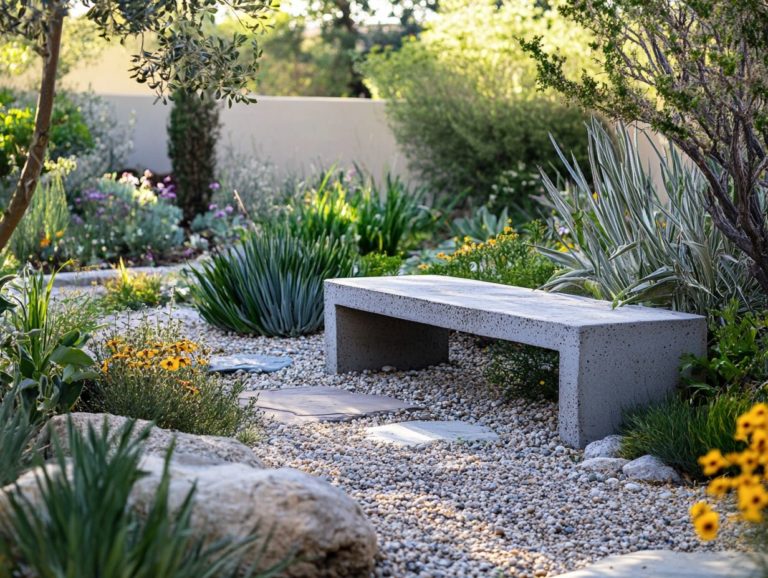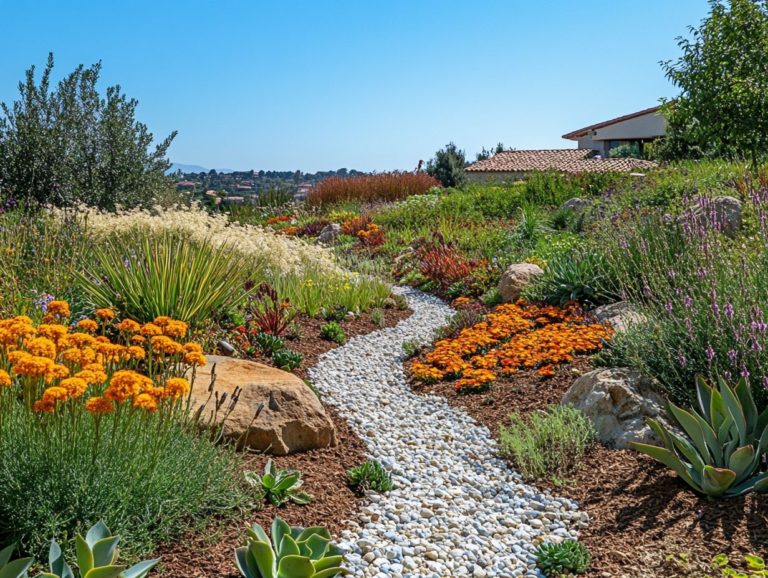5 Best Drought-Resistant Vines for Trellises
Are you eager to enhance the beauty and resilience of your garden? Drought-resistant vines present an exceptional opportunity for your trellises, bringing vibrant colors and fascinating textures while demanding minimal water. Get ready to explore five breathtaking options that will transform your garden!
Consider these stunning options:
- Bougainvillea
- Clematis
- Honeysuckle
- Wisteria
- Morning Glory
Discover what makes these vines flourish in dry conditions, how to properly care for them, and insightful tips for selecting the ideal vine and trellis for your space. Transform your garden with these hardy beauties and watch your outdoor oasis thrive!
Contents
Key Takeaways:

- Choose drought-resistant vines for your trellises to save water and reduce maintenance. Consider low-maintenance planting strategies for a hassle-free experience.
- Some great options include bougainvillea, clematis, honeysuckle, wisteria, and morning glory.
- Be sure to properly care for your vines and consider the type of trellis, including support structures and overall garden design before incorporating vines into your landscape.
1. Bougainvillea
Bougainvillea, with its striking blooms and resilience in hot gardens, is an excellent choice if you’re looking to add drought-resistant vines to your outdoor space. It thrives in areas that face high temperatures and limited rainfall.
This hardy plant flourishes in rich, moist soil that blends sandy and loamy textures, allowing for optimal water retention while preventing pesky root rot a condition where plant roots decay due to excess moisture.
When considering where to place it, Bougainvillea is perfect for creating vertical lines or privacy screens, seamlessly adding both color and structure to your garden.
To ensure a profusion of blossoms, proper care is key. These vines love basking in full sunlight and benefit greatly from regular pruning to encourage fresh growth. For the best blooming results, aim to plant Bougainvillea in early spring. A light trim can work wonders, promoting healthier blooms and more vigorous foliage throughout the growing season.
2. Clematis
Clematis stands out as a premier choice among climbing plants, renowned for its breathtaking floral displays and adaptability to various support structures. This versatility makes it a splendid addition to your garden design.
These remarkable plants come in a plethora of species, each showcasing distinct sizes, shapes, and colors of blooms. For instance, the striking ‘Jackmanii’ dazzles from summer through fall, while the charming early-blooming ‘Nelly Moser’ brings springtime beauty to your garden. Thoughtfully selecting from these varieties ensures a vibrant and continuous color palette throughout the growing season.
To thrive, clematis prefers well-drained, fertile soil that retains moisture without becoming overly saturated. Regular pruning is essential; the techniques differ depending on the species, but adhering to these guidelines will reward you with abundant blooms and lush foliage. With the right care and attention, these plants can elevate the garden aesthetics of any landscape significantly.
3. Honeysuckle
Honeysuckle is celebrated for its sweet-smelling flowers and its enchanting ability to climb on fences and trellises. This climbing perennial not only adds beauty to your garden but also offers pest resistance, making it a favorite among those seeking a touch of elegance. Incorporating it into your design can bolster your garden aesthetics.
Within the honeysuckle family, you’ll discover several varieties, each boasting its own unique traits tailored to various gardening needs. Some thrive in full sun while others prefer the cozy embrace of partial shade. It’s crucial to select the right species based on your garden s specific light conditions.
Honeysuckle generally flourishes in well-drained, loamy soil, though it is surprisingly adaptable and can thrive in a range of soil types. By incorporating these delightful plants into your vertical garden, you can create stunning living walls that attract butterflies and bees while elevating the overall aesthetic and health of your outdoor space.
Don’t wait to beautify your space start planting these incredible vines today!
4. Wisteria

Wisteria dazzles with vibrant blooms. Proper management keeps it in check to prevent invasiveness.
To thrive, this plant favors well-drained soil enriched with decomposed leaves and compost. It demands full sun for optimal blooming. When cultivating Wisteria, using mulch helps retain moisture and suppress weeds.
Understanding pruning is vital for maintaining its beauty. Regular trimming in late winter or early spring enhances blooms and controls its vigorous nature.
5. Morning Glory
You’ll love the rapid growth and vibrant blooms of Morning Glory. This delightful plant thrives in full sunlight, making it perfect for low-maintenance options that quickly cover trellises.
Morning Glory offers a variety of species, each with unique colors and seasons. It flourishes best in well-drained soil, particularly sandy or loamy types for healthy roots.
While you can use Morning Glory as a stunning focal point or ground cover, its vigorous growth may lead to invasiveness without proper management. With strategic placement, these climbing beauties can elevate your garden design.
What Makes These Vines Drought-Resistant?
Understanding what makes certain vines drought-resistant is key for gardening in arid climates, especially in regions like Arizona.
Drought-resistant plants have special features. For example, their deep root systems help them find water underground, while waxy leaves reduce evaporation.
When selecting drought-tolerant vines, look for varieties with these traits for better survival in challenging climates.
Providing good care means ensuring proper soil drainage, applying mulch to retain moisture, and monitoring for pests that might threaten their resilience.
How to Care for Drought-Resistant Vines
Caring for drought-resistant vines requires a thoughtful approach. Start with the right soil for a solid base.
Establish effective support structures to guide their growth. Use proper pruning techniques for sustained vitality.
Develop a well-planned watering schedule that aligns with the vines’ natural hydration needs. Water deeply but less frequently to encourage strong roots.
Incorporating organic soil amendments like compost can enhance moisture retention.
When it comes to support structures, proper installation is key. Ensure vines grow upright without unnecessary strain. Timing your pruning correctly, especially during the dormant season, promotes healthier growth and better air circulation.
Staying vigilant against pests with natural deterrents can further enhance the survival and resilience of your plants.
What Are the Benefits of Using Vines for Trellises?

Utilizing climbing plants on trellises offers you a host of benefits that can elevate your garden’s aesthetics. Not only do they create striking vertical lines, but they also enhance privacy and streamline low-maintenance planting strategies within any landscape design.
Trellises do more than beautify your outdoor space. They serve essential functions that contribute to a healthier garden ecosystem. By helping plants grow upward, you can make the most of your usable space, transforming even the coziest areas into an expansive oasis.
Trellises provide vital habitats for beneficial insects, which are crucial for pollination and pest control. They also improve air circulation around your plants, helping to reduce moisture retention and lower the risk of disease.
For instance, varieties like clematis and morning glory absolutely thrive on traditional lattice trellises. Staked grapevines and kiwis flourish on robust, arched designs. Each plant contributes to your garden’s beauty in its unique way, enhancing the overall experience you create.
How to Choose the Right Vine for Your Trellis
Choosing the right climbing plants for your trellis involves thoughtful consideration of several factors, including USDA hardiness zones, growth habits, and how likely they are to spread. This ensures that your garden design is not only successful but also harmonious.
As you evaluate various vines, assess their growth patterns. Pay attention to how quickly they climb and whether they require any support. Understanding their sunlight needs will guide you in selecting the ideal location for your trellis; some vines flourish in full sun, while others prefer a bit of dappled shade.
Being aware of local pests is crucial, as certain species may resist common threats or even assist in pest control when paired with more vulnerable plants. Keep an eye on invasive plants to maintain a healthy garden. Matching your chosen vines with the right trellis type be it flat, vertical, or arch style will enhance both their growth and aesthetic appeal.
Finally, consider proactive management strategies to address invasive species, ensuring the balance and biodiversity of your garden remains intact.
What Are the Different Types of Trellises?
Trellises come in many designs and materials. Each one supports climbing plants and enhances your garden s beauty.
Among the most popular options, wooden trellises exude rustic charm and effortlessly blend into the natural landscape, making them an ideal choice for traditional gardens. In contrast, metal trellises bring a modern flair with their sleek designs and impressive durability, perfectly suited for contemporary settings.
Then there are living trellises, crafted from interwoven branches or vines, which introduce a dynamic, organic element that invites a sense of lushness. These structures do more than just support your plants; they also provide visual interest, serving as backdrops or focal points that elevate the overall design of your garden while promoting healthy growth.
Imagine transforming your garden into a lush paradise! Start planning your trellis today and watch your garden thrive!
How to Incorporate Vines into Your Garden Design
Incorporating climbing plants into your garden design elevates the visual appeal and enhances functionality. They are essential for growing plants upwards and are a brilliant solution for low-maintenance planting.
Consider using things like trellises or arches to maximize space. These versatile plants can effortlessly integrate into various garden styles.
Whether you re aiming for the whimsical charm of a cottage garden or the sleek sophistication of a modern landscape, carefully selecting species that complement the surrounding flora can cultivate a cohesive and inviting atmosphere.
Make sure to check each vine’s growth requirements, such as sunlight and soil types. This ensures they thrive and contribute to the beauty of your space.
For instance, many climbing perennials thrive in full sun, while others may prefer partial shade. Implementing trellises or arches adds structure and balance, encouraging healthy growth and allowing other plants to shine.
Frequently Asked Questions

What are the best vines for trellises in drought-prone areas?
Some of the best drought-resistant vines for vertical spaces include Bougainvillea, clematis, Wisteria, trumpet vine, and hacienda creeper.
How do I know if a vine is drought-resistant?
Drought-resistant vines can withstand dry conditions and have adapted to store water in their leaves, stems, or roots. For example, Creeping fig and Arizona grape ivy are excellent choices.
They also have deep root systems that can access water from deeper soil layers.
Can I grow these vines in containers?
Yes, all of these vines can be grown in containers. Just make sure to choose a large enough container and use well-draining soil to prevent waterlogging.
Using hanging baskets is another great way to display climbing plants.
Do these vines require any special care?
While these vines are drought resistant, it s vital to water regularly during the crucial first year of growth. After that, they may only need occasional watering during prolonged dry periods.
Using rich moist soil can help retain moisture.
How often should I water these vines?
Once established, these vines should only need watering once or twice a week during dry periods. However, it’s always best to check the soil moisture level and adjust accordingly.
Can these vines be grown in full sun?
Most of these vines prefer full sun, but some, like Carolina jessamine, may benefit from partial shade. Always check the specific light requirements for each vine before planting.






